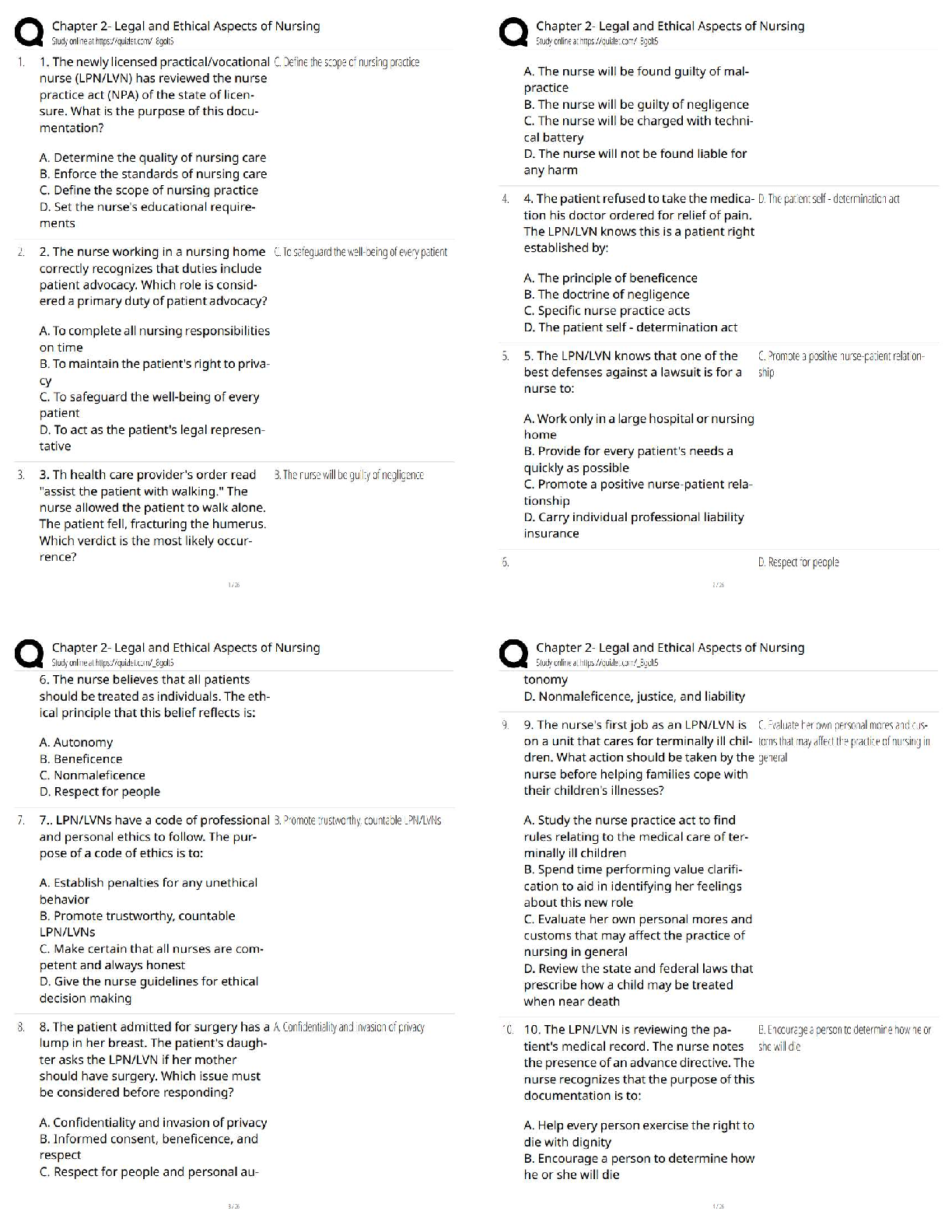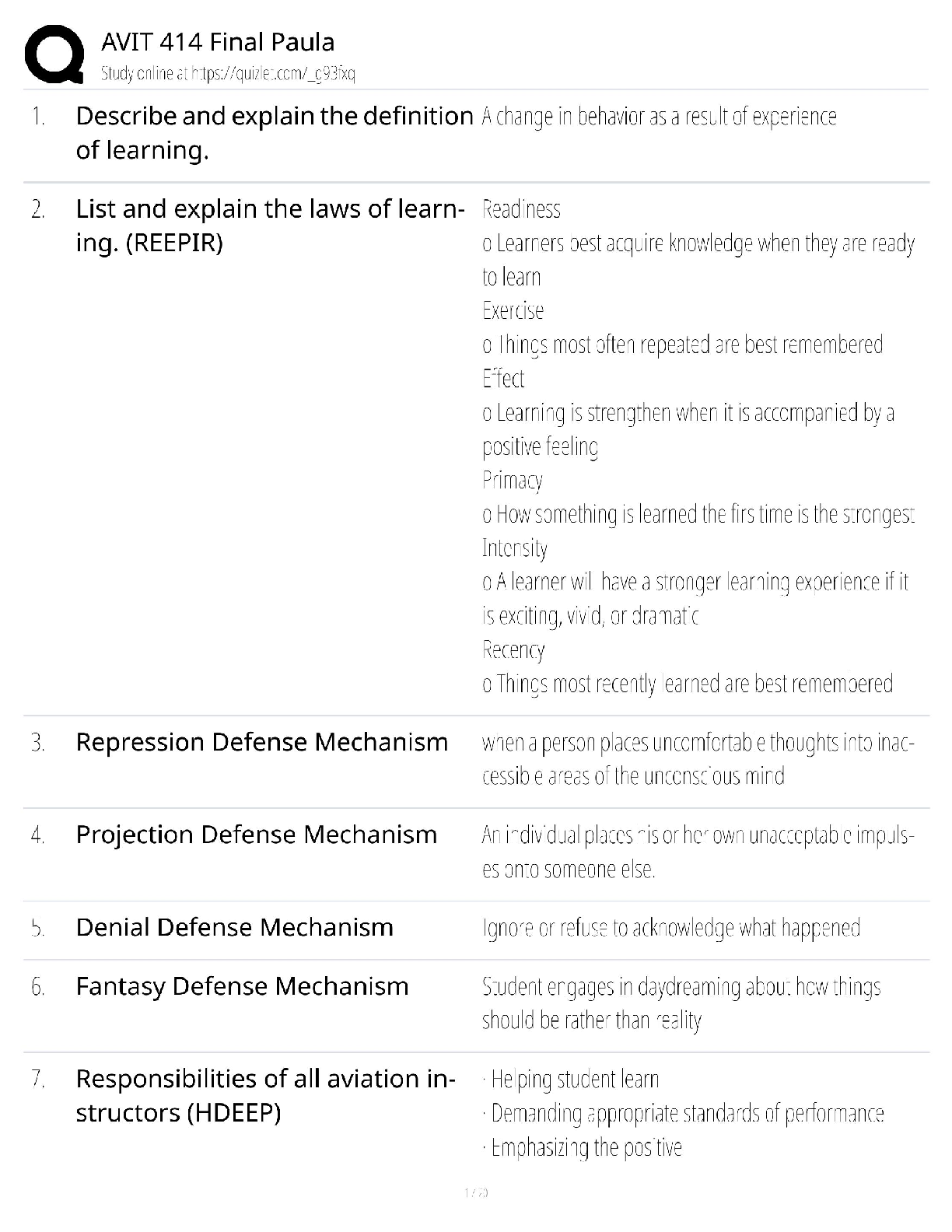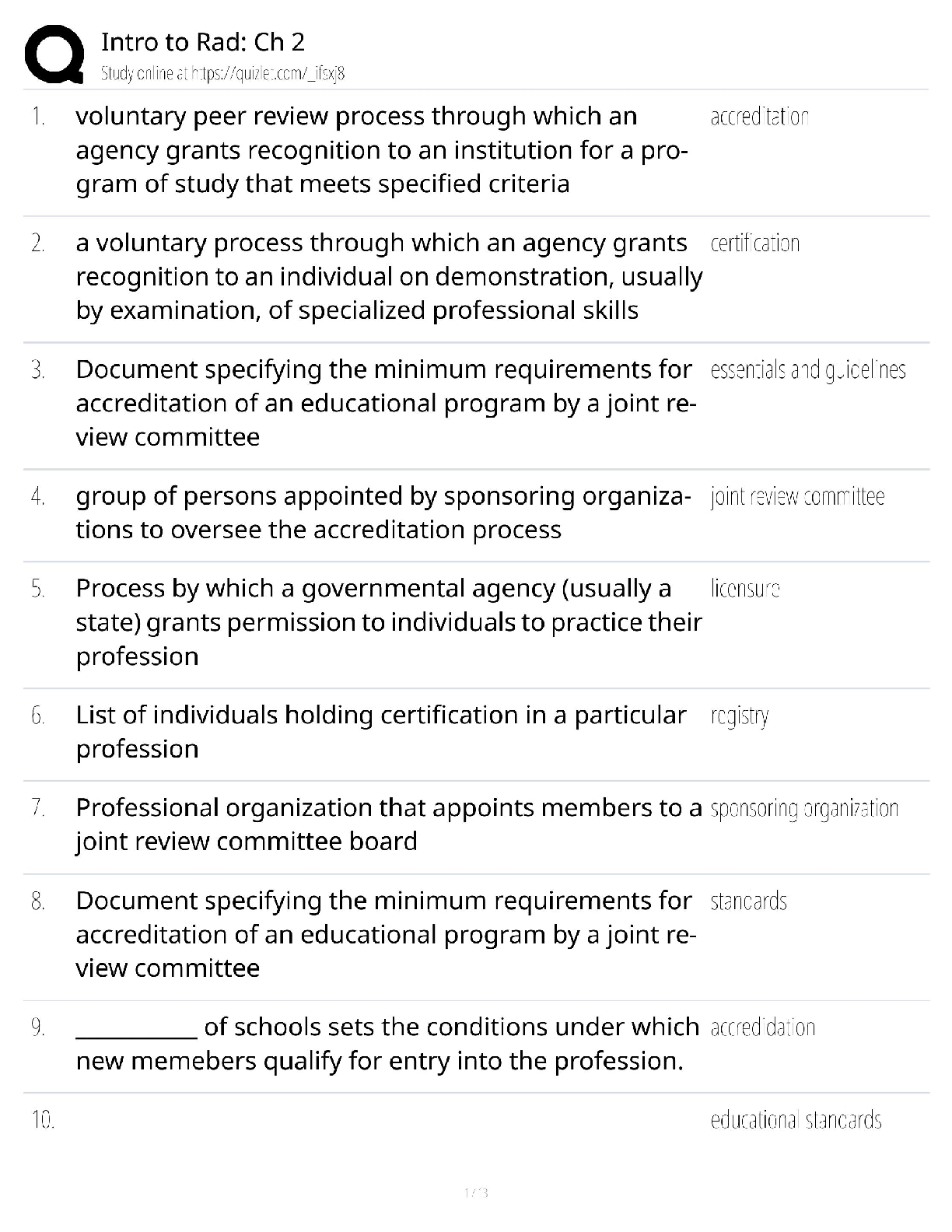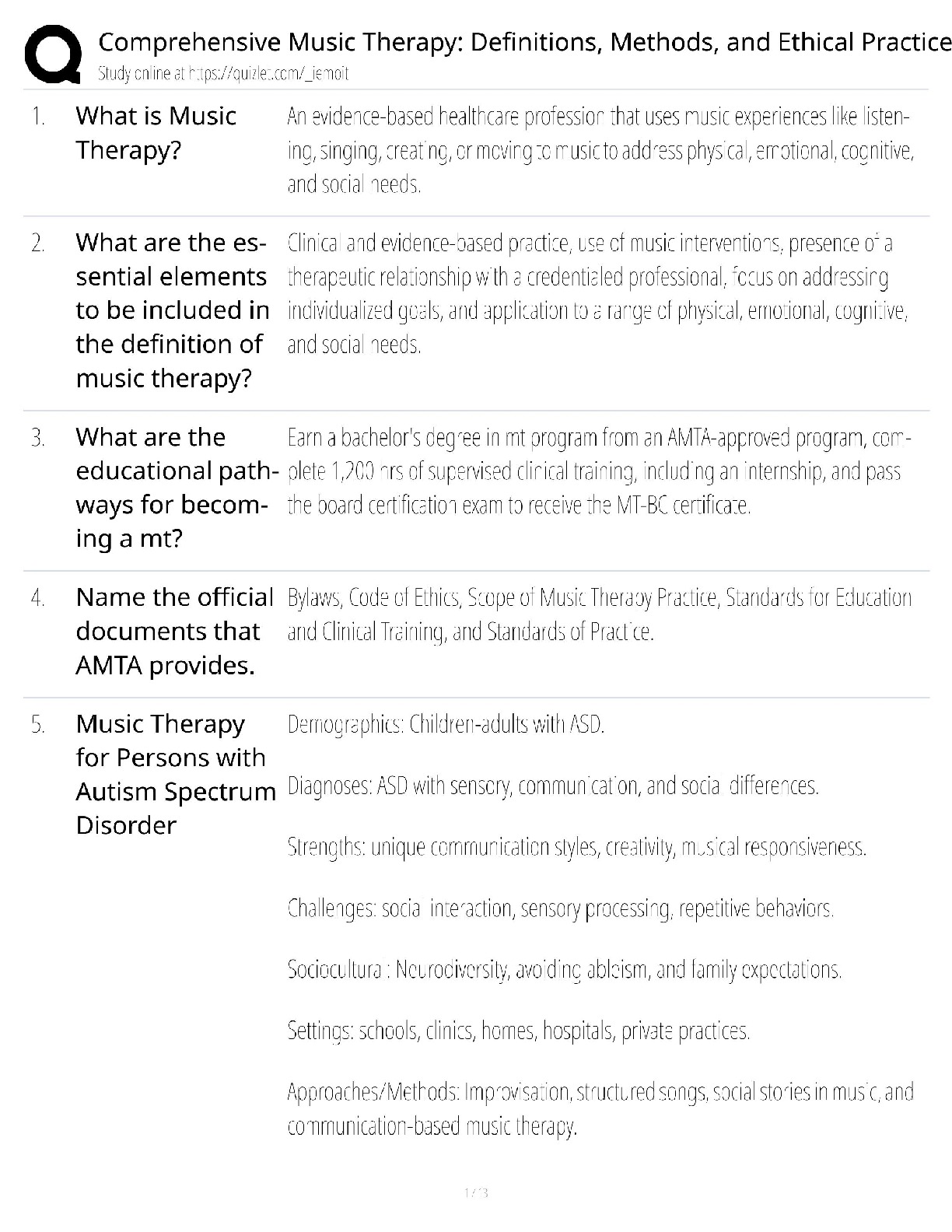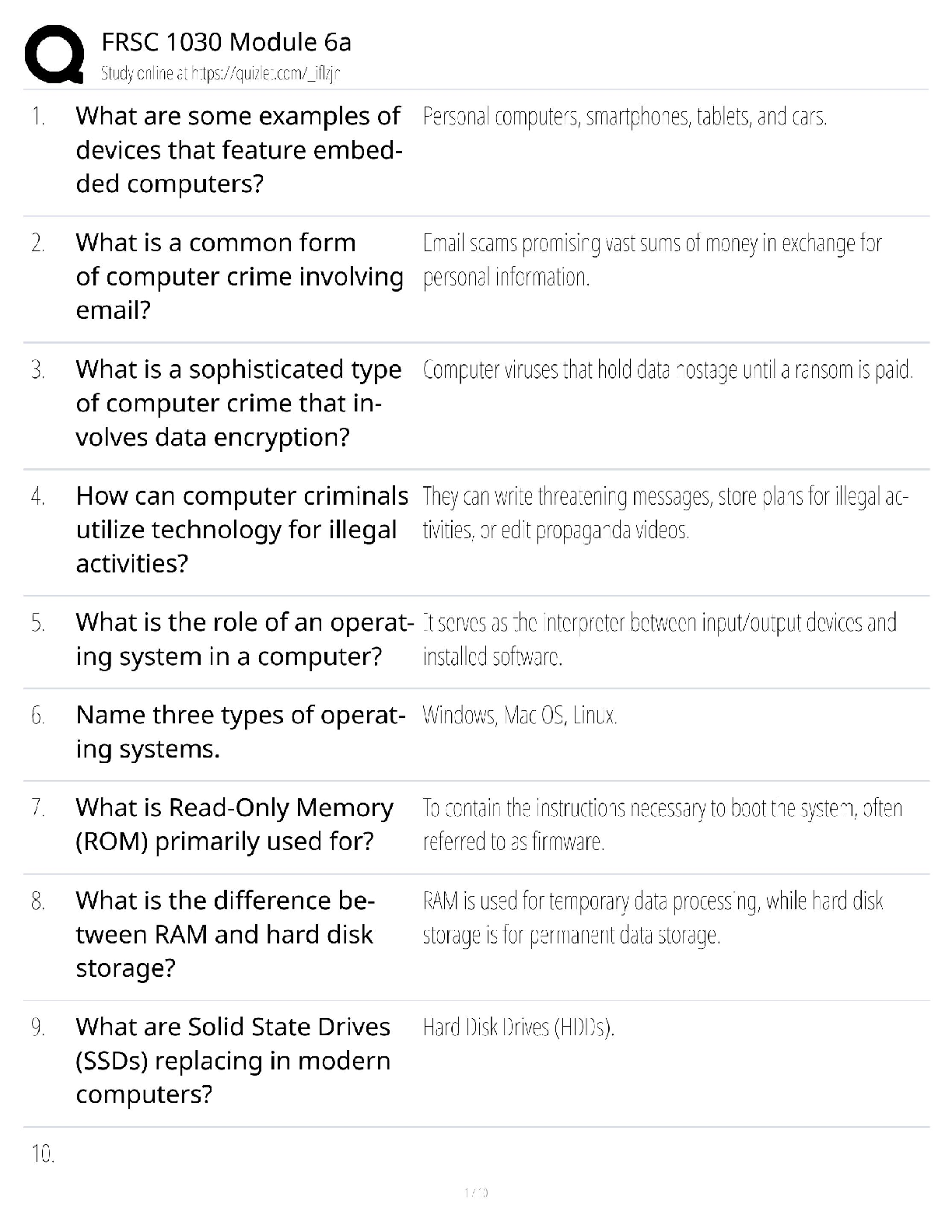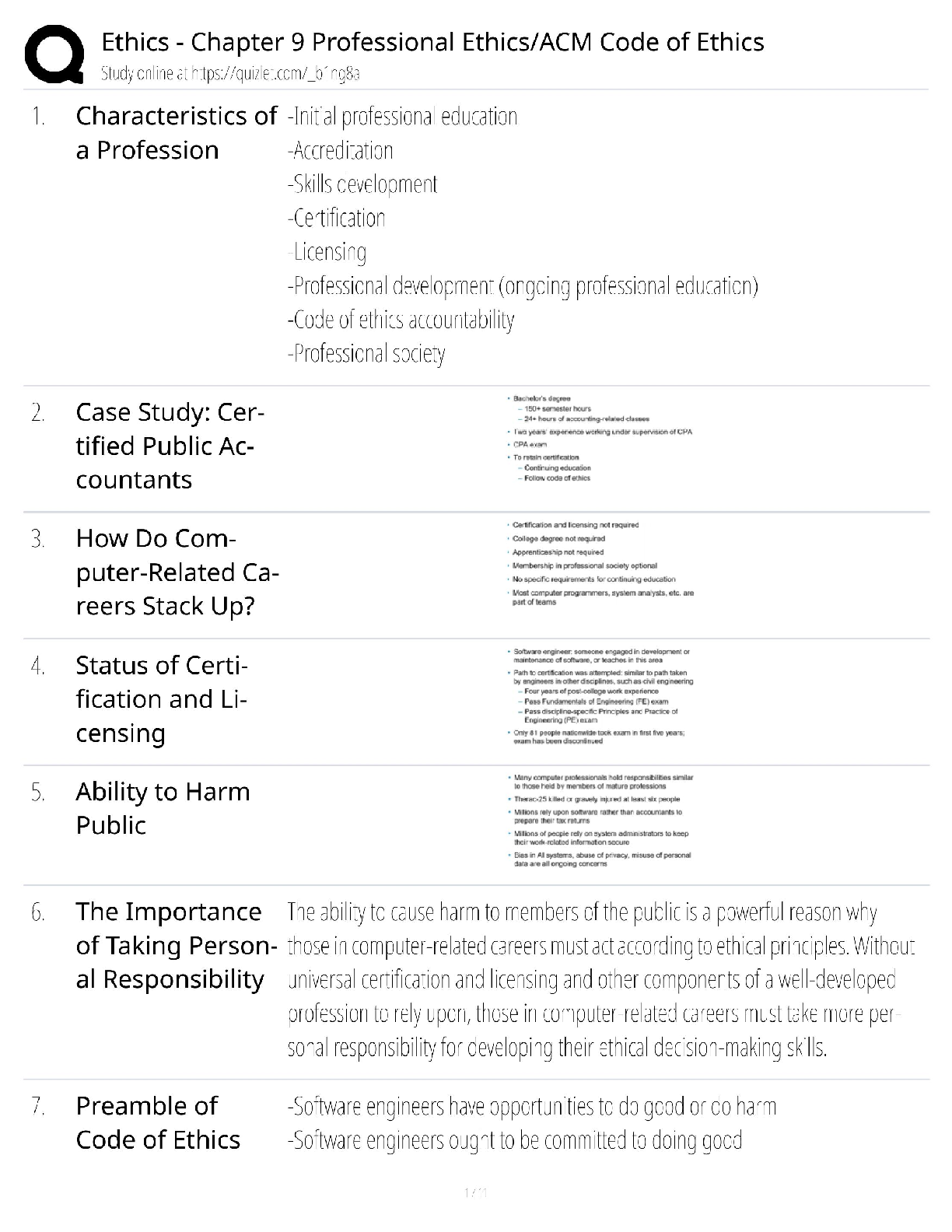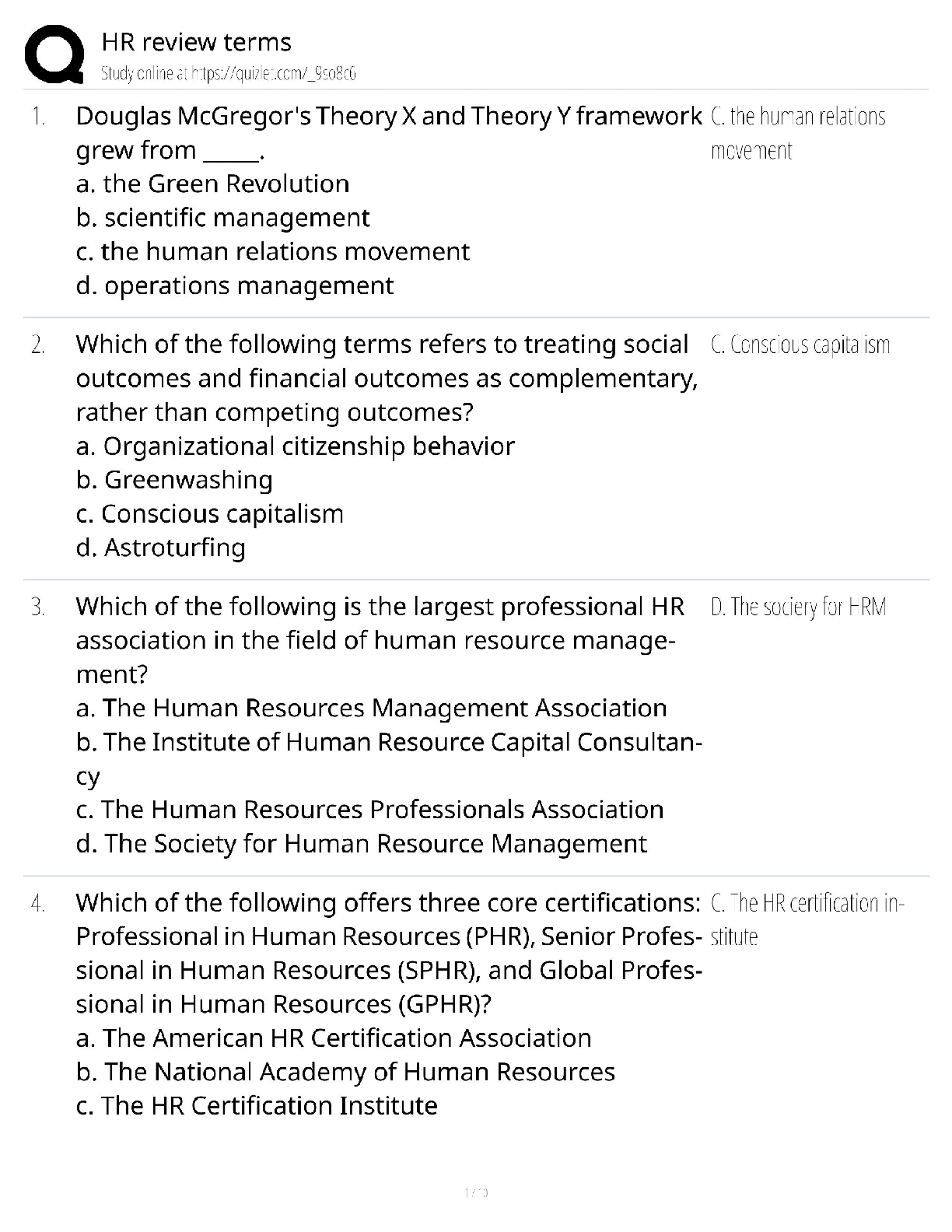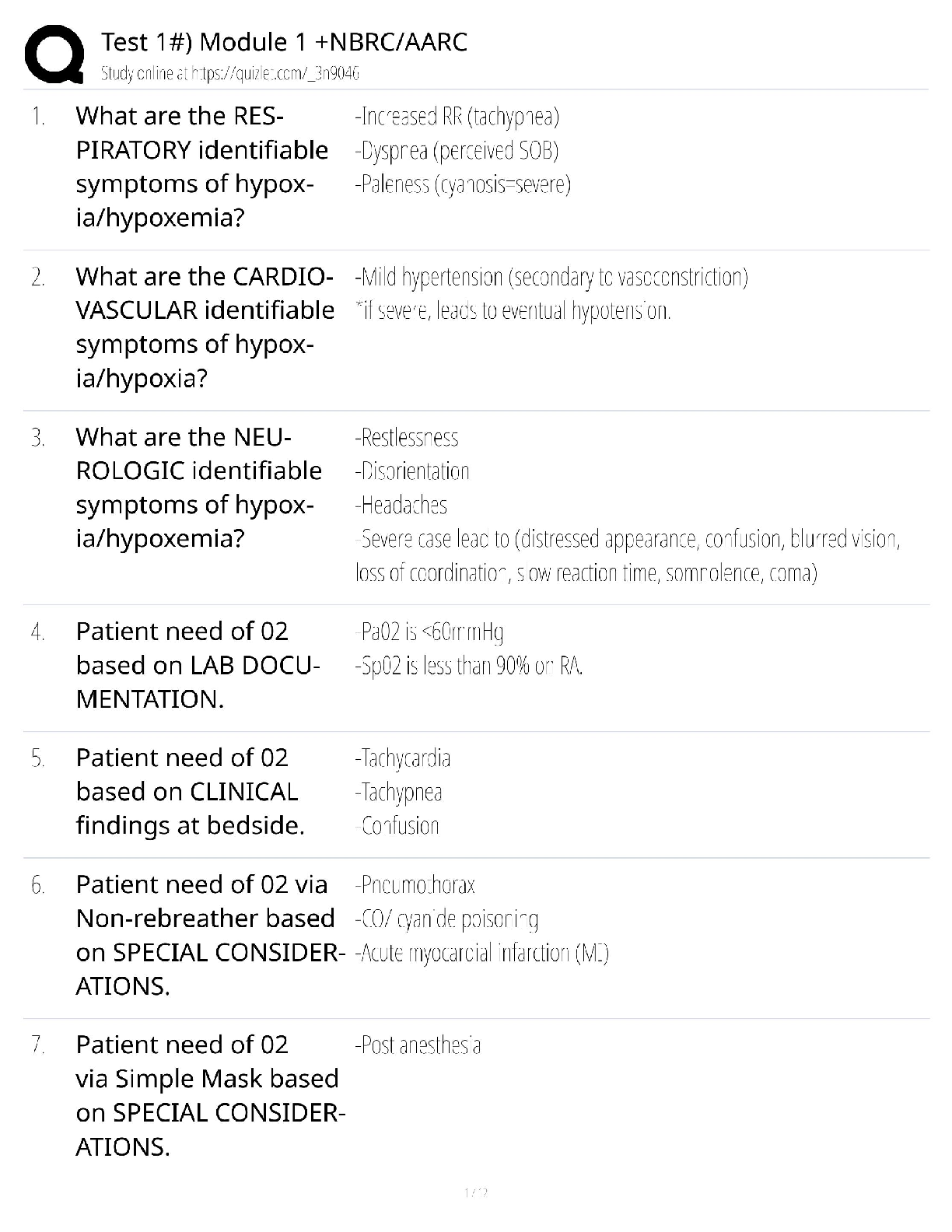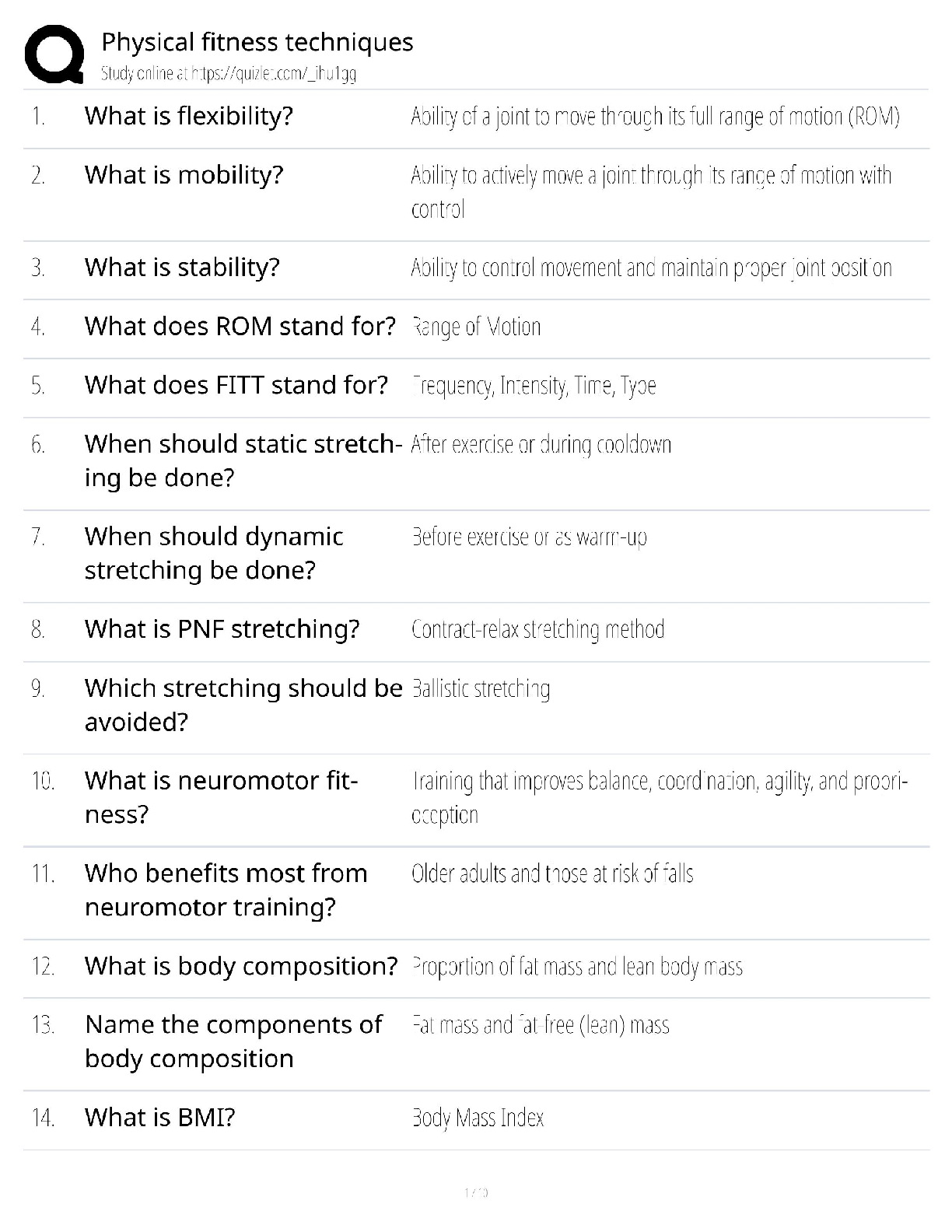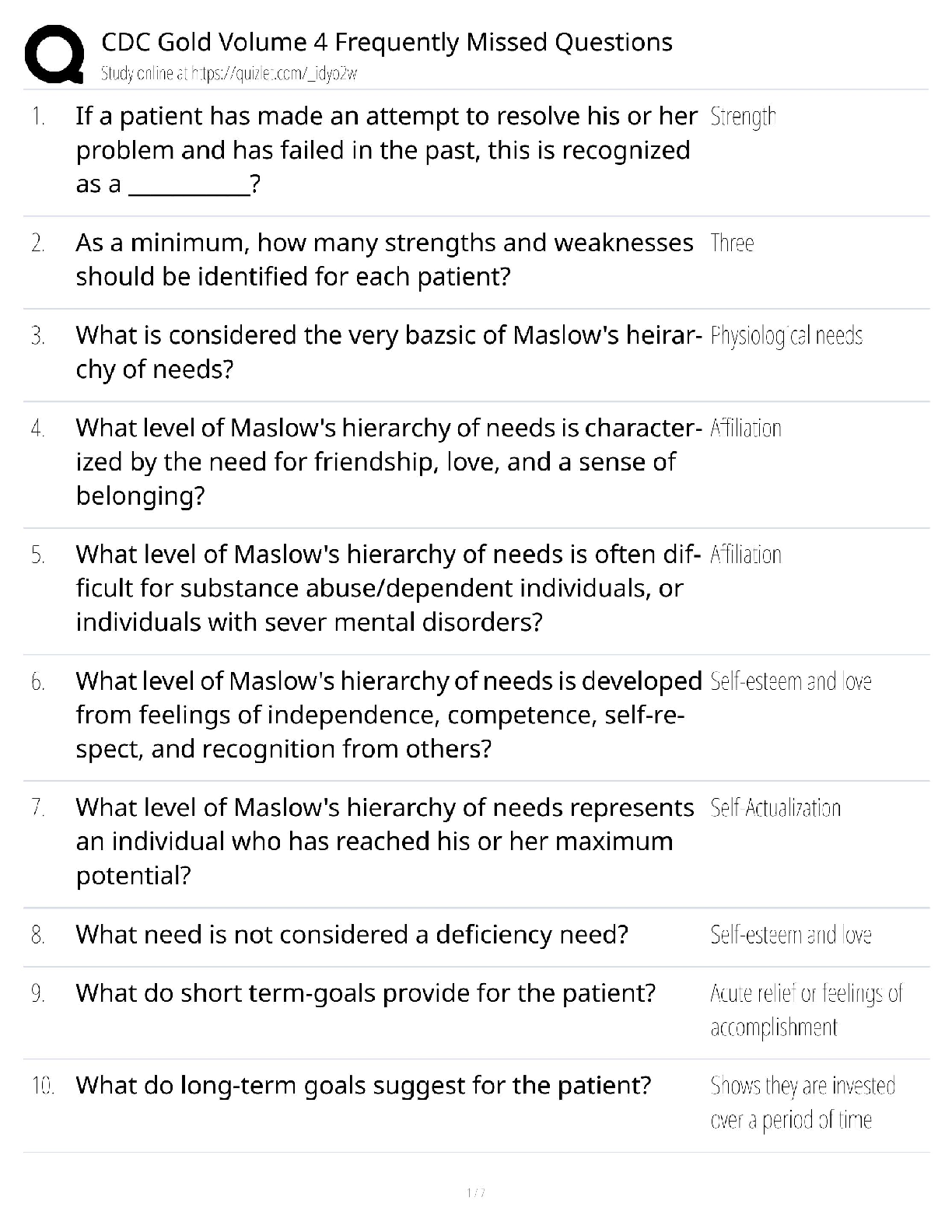*NURSING > QUESTIONS & ANSWERS > TMC Exam C Questions and answers. Graded A+, latest Update (All)
TMC Exam C Questions and answers. Graded A+, latest Update
Document Content and Description Below
TMC Exam C Questions and answers. Graded A+, latest Update a. manual dexterity - QUIZ?The respiratory therapist should evaluate which of the following to develop a teaching plan for a patient who ... will be using a small volume nebulizer at home? a. manual dexterity b. highest grade level achieved in school c. spousal support d. English speaking proficiency d. bronchoscopy - QUIZ?Which of the following would be most beneficial in resolving microatelectasis? a. chest tubes b. percutaneous ventilation c. thoracentesis d. bronchoscopy b. oropharyngeal airway - QUIZ?A 45 year-old patient is recovering in the intensive care unit after undergoing a surgical procedure to repair a hernia. The patient remains unconscious. To prevent soft tissue obstruction, the respiratory therapist should recommend a(n) a. double-lumen endobronchial tube b. oropharyngeal airway c. bite block d. nasopharyngeal airway d. Run 2 only - QUIZ?Quality control material has published values for pH of 7.20, PO2 of 65 mmHg. Documentation indicates the range of pH is 0.5% and is 3% for PO2. Machine results are as follows: Run 1: pH 7.19, PO2 64 Run 2: pH 7.10, PO2 69 Run 3: pH 7.21, PO2 65 Which quality control run(s) indicate the machine is out of control? a. Run 1 and 2 b. Run 2 and 3 c. Run 3 only d. Run 2 only a. ABG and alveolar oxygen tension - QUIZ?A respiratory therapist is considering a patient's readiness to wean from mechanical ventilation. To determine the A-aDO2, the therapist will need which of the following? a. ABG and alveolar oxygen tension b. VD/VT and PAO2 c. CaO2 and PAO2 d. VD/VT and ABG c. heliox therapy - QUIZ?A patient with increased airway resistance from a fixed upper airway obstruction would benefit most from which of the following? a. bronchodilator therapy b. epinephrine c. heliox therapy d. aerosolized atropine d. inspiratory muscle strength - QUIZ?Evaluating MIP (maximum inspiratory pressure) is most useful in evaluating which of the following? a. presence of a restrictive pulmonary defect b. effectiveness of cough c. presence of obstructive pulmonary defect d. inspiratory muscle strength b. excess water in the tubing - QUIZ?An air-entrainment jet nebulizer is set at 50%. The respiratory therapist analyzes the oxygen coming from the end of the tubing and finds it is 60%. Which of the following most likely explains this finding? a. poorly calibrate analyzer b. excess water in the tubing c. low flow through the jet orifice d. leak in the tubing a. examine the ventilator circuit for proper connections - QUIZ?During a preoperational test of the ventilator with a test lung, the respiratory therapist notes a return tidal volume of 600 cc. Ventilator settings are: Mode: Assist/control FiO2: 0.50 Mandatory rate: 10 VT: 750 mL What action should the therapist take? a. examine the ventilator circuit for proper connections b. obtain a larger test lung c. increase the set tidal volume to 900 mL d. obtain a smaller test lung d. change the fuel cell - QUIZ?During the preoperational test of the ventilator, the respiratory therapist notices the galvanic analyzer on the ventilator is reading erroneously low. Which of the following can the respiratory therapist do to correct the problem? a. replace the analyzer batteries b. replace the electrolyte solution in the analyzer c. tag the ventilator as non-functional and avoid placing it in service d. change the fuel cell b. poor hand washing among staff - QUIZ?Which of the following is most likely to increase nosocomial infection in a hospital? a. use of an HME for 48 hours b. poor hand washing among staff c. frequent disconnection in the ventilator circuit d. use of alcohol-based hand cleaners b. disconnected thermistor line - QUIZ?While monitoring a patient receiving mechanical ventilation, the respiratory therapist notices the low-pressure and low exhaled volume alarms are sounding. Which of the following could be the cause? a. kinked endotracheal tube b. disconnected thermistor line c. excess water in the inspiratory limb of the circuit d. herniated endotracheal tube cuff a. a fracture in the plastic wye - QUIZ?A patient receiving positive pressure ventilation has a low-pressure alarm sounding. Which of the following could be the cause? a. a fracture in the plastic wye b. herniated cuff c. excess secretions in the airway d. kinked ET tube a. provide manual ventilation - QUIZ?The high pressure alarm is sounding on a patient receiving volume controlled ventilation. The respiratory therapist should FIRST a. provide manual ventilation b. suction the patient c. observe the alarm panel to determine source d. cancel the alarm d. Anectine (succinylcholine chloride) - QUIZ?Which of the following medications is shown to have sufficient affect when facial muscle twitching is observed? a. Halcion b. Curare (d-turbo curare) c. Romazicon d. Anectine (succinylcholine chloride) d. respirometer - QUIZ?A respiratory therapist is preparing to measure SVC on a patient in the emergency department. Which of the following equipment is required? a. Collins water-seal spirometer b. Geissler tube c. Wheatstone bridge d. respirometer b. pressure manometer - QUIZ?A respiratory therapist is asked to determine a patient's inspiratory muscle strength. Which of the following equipment is required for this evaluation? a. Fleisch pneumotrachometer b. pressure manometer c. respirometer d. peak flow meter b. peak flow meter - QUIZ?A respiratory therapist is ordered to do a bedside assessment of the effectiveness of a bronchodilator on a patient with an acute asthmatic episode. Which of the following equipment will be needed to perform this evaluation? a. maximum inspiratory pressure manometer b. peak flow meter c. Collins water-seal spirometer d. respirometer a. 25/8 mmHg - QUIZ?Which of the following pressures is most consistent with a normal pulmonary artery pressure (PAP)? a. 25/8 mmHg b. 12/8 mmHg c. 120/80 mmHg d. 25/4 mmHg d. change to an 80%/20% heliox mixture - QUIZ?A patient receiving heliox therapy at 70%/30% mixture by non-rebreathing mask has the following arterial blood gas results: pH 7.35 / PaCO2 45 / PaO2 110 / HCO3 24 / BE 0 Which of the following actions is appropriate? a. change to a heliox mixture of 60%/40% b. discontinue heliox therapy c. switch to a partial rebreathing mask d. change to an 80%/20% heliox mixture c. use an air-entrainment mask set at 28% - QUIZ?A COPD patient complains of shortness of breath while exercising with a 2 L/min nasal cannula. During exercise, SPO2 is noted to fall to 84%. Which of the following would be most helpful to the patient during exercise? a. decrease flow to 1 L/min nasal cannula b. avoid exercising c. use an air-entrainment mask set at 28% d. use a non-rebreathing mask a. place the patient on a non-rebreathing mask - QUIZ?A patient in the emergency room is receiving oxygen by nasal cannula at 3 L/min. Blood gases reveal the following: pH 7.53 / PaCO2 30 / PaO2 51 / HCO3 23 / BE -1 The respiratory therapist should immediately a. place the patient on a non-rebreathing mask b. decrease flow to 1 L/min c. increase flow to 5 L/min d. place the patient on a Venturi mask at 40% d. increase PEEP to 22 cmH2O - QUIZ?An 80-kg (176-lb) female patient is receiving mechanical ventilation on the following settings: Mode: assist/control Mandatory rate: 14/min Total rate: 14/min VT: 550 mL FiO2: 0.60 PEEP: 20 cmH2O ABG: pH 7.38 / PaCO2 42 / PaO2 62 / HCO3 26 / BE +2 The respiratory therapist should a. increase the FIO2 to 0.7 b. order a chest radiograph c. increase FiO2 to 1.0 d. increase PEEP to 22 cmH2O b. increase flow to 15 L/min - QUIZ?A patient is showing signs of respiratory distress with a respiratory rate to 30/min and a spontaneous tidal volume of 800 mL. The patient is receiving oxygen at 60% by large volume nebulizer with the flow set at 10 L/min. The respiratory therapist should suggest to a. increase FiO2 to 1.0 and the flow to 15 L/min b. increase flow to 15 L/min c. sedate the patient d. decrease the FiO2 to 0.50 d. decrease inspiratory time - QUIZ?The physician orders a change in I:E ratio from 1:2 to 1:4 for a COPD patient receiving volume-cycled mechanical ventilation. Which of the following accommodates the physician's request if the mandatory rate is not changed? a. increase the inspiratory time b. decrease the inspiratory flow rate c. decrease expiratory time d. decrease inspiratory time a. autoPEEP - QUIZ?For a patient receiving volume-controlled ventilation in the assist/control mode, the starting of the inhalation cycle before the expiratory flow rate returns to zero would result in which of the following? a. autoPEEP b. atelectasis c. alveolar collapse d. decreased FRC c. epinephrine - QUIZ?While assisting a physician during a bronchoscopy procedure, the therapist notices bright red blood in the specimen tube. The therapist should prepare which of the following NEXT? a. Heparin b. atropine c. epinephrine d. cold normal saline d. Bodai adapter - QUIZ?A respiratory therapist is asked to assist a physician with a bronchoscopy procedure on a patient who is ventilator dependent and requires high levels of PEEP. Which of the following equipment should be used? a. closed in-line suction catheter b. manual PEEP valve c. Magill forceps d. Bodai adapter b. reduce future treatment dosage to 0.25 mL - QUIZ?A patient receiving 0.5 mL Albuterol by small volume nebulizer complains of tingling fingers, nervousness, and heart palpitations. The therapist should a. decrease dosage to 0.15 mL b. reduce future treatment dosage to 0.25 mL c. have the patient pause at the top of each breath d. instruct the patient in performing shallow inspirations a. cancerous mass in the lung - QUIZ?For which of the following is the respiratory therapist observing if obtaining a series of oblique chest radiographs? a. cancerous mass in the lung b. pneumonia c. pneumothorax d. pleural effusion d. mass in the left lobe - QUIZ?A spiral CT scan would be most helpful in evaluating which of the following? a. atelectasis b. asbestosis c. pneumonia d. mass in the left lobe b. decrease tidal volume - QUIZ?A 65-kg (143-lb) patient with pneumonia is receiving mechanical ventilator support by a Servo adult ventilator on the following settings with corresponding arterial blood gas values: Mode: assist/control Mandatory rate: 10/min VT: 700 mL FiO2: 0.50 pH 7.48 / PaCO2 33 / PaO2 98 / HCO3 24 / BE 0 Which of the following actions is most appropriate? a. increase tidal volume b. decrease tidal volume c. decrease FiO2 d. decrease mandatory rate b. increase alveolar ventilation - QUIZ?A patient is undergoing a full cardiopulmonary arrest. The patient is intubated and is being monitored with an infrared capnographic device. PetCO2 data is showing 3%. Which of the following is most appropriate? a. obtain PaCO2 by a Douglas bag b. increase alveolar ventilation c. recalibrate the capnometer d. clean the infrared device c. ET tube markings at the lips - QUIZ?Which of the following can be examined to initially determine the approximate position of the oral endotracheal tube? a. chest radiograph b. lateral neck radiograph c. ET tube markings at the lips d. diaphragmatic excursion a. radiologist reports the ET tube is 1 inch above the carina - QUIZ?Which of the follow data, if observed, would indicate proper positioning of an oral endotracheal tube? a. radiologist reports the ET tube is 1 inch above the carina b. end of ET tube 2 cm below the aortic knob c. end of ET tube is 6 cm above the carina d. poor left chest symmetry d. racemic epinephrine - QUIZ?A child has been extubated and is demonstrating mild stridor. Which of the following agents would be most helpful to administer by aerosol? a. albuterol b. Atropine c. Aminophylline d. racemic epinephrine b. ventilator circuit bronchoscopy adapter - QUIZ?A respiratory therapist is asked to assist a physician for a diagnostic bronchoscopy on a mechanically ventilated patient. What special equipment should be brought to the room? a. laryngoscope and blade b. ventilator circuit bronchoscopy adapter c. ventilator circuit endotracheal tube wedge d. Wrights respirometer d. stroke volume - QUIZ?Which of the following data is needed to calculate cardiac output? a. VO2 b. QS/QT c. A-aDO2 d. stroke volume c. IC - QUIZ?Which of the following volumes is being observed when a patient is using a volume-type incentive spirometer? a. ERV b. TLC c. IC d. IRV b. cystic fibrosis - QUIZ?For which of the following conditions is chest wall oscillation therapy most beneficial? a. ARDS b. cystic fibrosis c. drug overdose d. Guillain-Barre syndrome a. hemoglobin - QUIZ?Which of the following is needed to determine C(a-v)O2? a. hemoglobin b. VD/VT c. PvO2 d. PaO2 c. combined metabolic and respiratory acidosis - QUIZ?Arterial blood gases on a patient in the cardiac intensive care unit are as follows: pH 7.10 / PaCO2 52 / PaO2 65 / HCO3 15 / BE -9 Which of the following represents an accurate interpretation of these results? a. metabolic compensated respiratory acidosis [Show More]
Last updated: 3 years ago
Preview 1 out of 41 pages
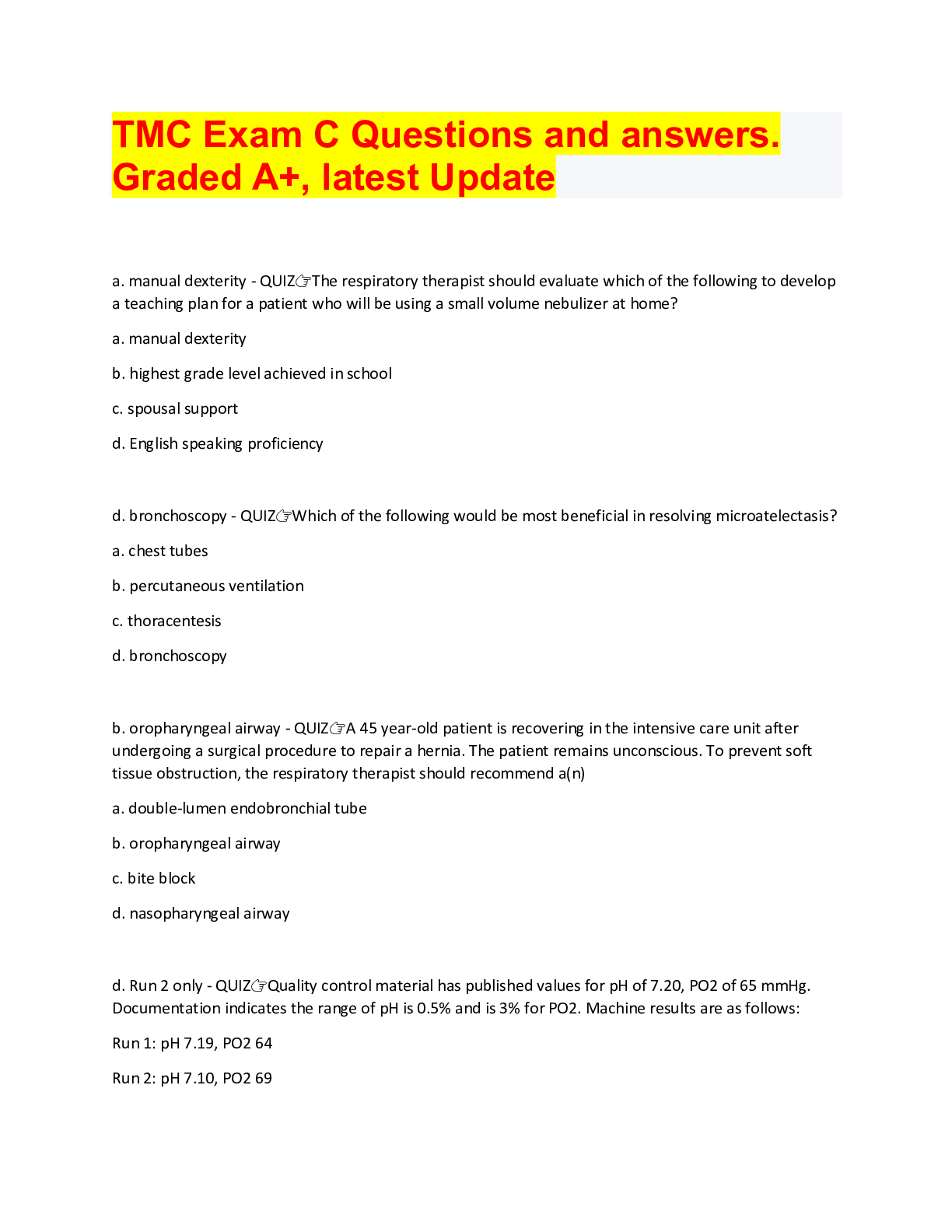
Buy this document to get the full access instantly
Instant Download Access after purchase
Buy NowInstant download
We Accept:

Also available in bundle (1)
Click Below to Access Bundle(s)

TMC EXAM BUNDLE, QUESTIONS WITH ACCURATE ANSWERS
ALL VERSIONS OF TMC EXAM PAPERS, BUNDLED QUESTIONS WITH ANSWERS, LATEST UPDATES
By bundleHub Solution guider 3 years ago
$38
16
Reviews( 0 )
$10.00
Can't find what you want? Try our AI powered Search
Document information
Connected school, study & course
About the document
Uploaded On
Aug 25, 2022
Number of pages
41
Written in
All
Seller

Reviews Received
Additional information
This document has been written for:
Uploaded
Aug 25, 2022
Downloads
0
Views
113













